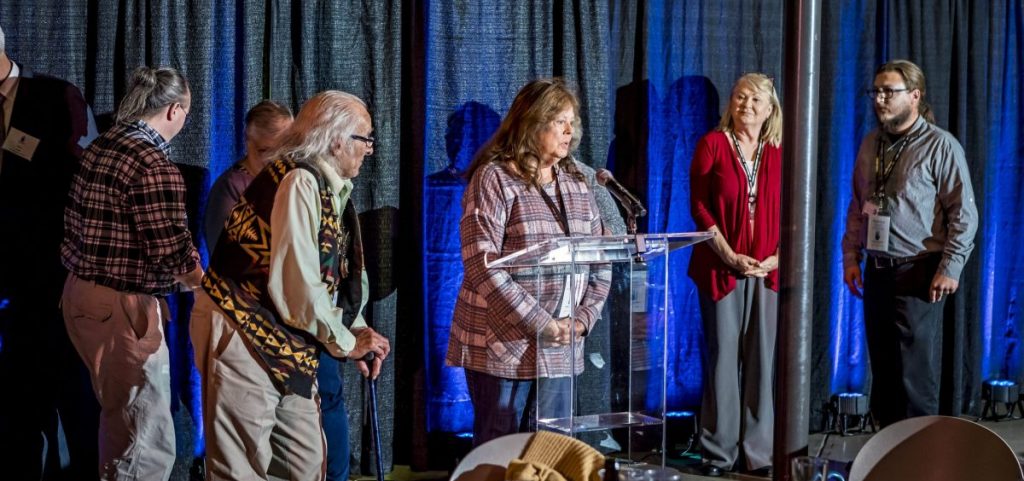News
An Ohio organization is No. 2 in Native American artifacts required to be returned by federal law. What’s being done?
By: Tana Weingartner | WVXU
Posted on:
CINCINNATI, Ohio (WVXU) — A federal law from 1990 requires institutions like museums and universities that receive federal funding to return Native American artifacts — things like hundreds of thousands of human remains, funerary objects and other items. Ohio’s historical society, called Ohio History Connection, holds the second largest collection of objects in the country.
The National Park Service maintains an inventory of collections the institutions were required to submit under the Native American Graves Protection and Repatriation Act (NAGPRA). The list includes some 870,000 objects, but it’s limited to public institutions. There are unknown hundreds of thousands of human remains and other artifacts tucked away in private collections. (Though Indian Country Today reported last year that NAGPRA may apply if private museums have accepted federal stimulus money.)
Alex Wesaw is director of the American Indian Relations division for Ohio History Connection (OHC), and a member of the Pokagon Band of Potawatomi. He spoke with WVXU’s Tana Weingartner about the slow process of repatriating nearly 118,000 people and objects.

On why Ohio History Connection has so many objects
Wesaw says one reason Ohio History Connection ranks so high on the park service inventory list of institutions is because one reason the organization was created was to keep artifacts from being taken out of state. (The University of California at Berkeley is No. 1.)
“Back in 1885 when our organization was founded, there were a ton of archaeological materials — individuals, associated funerary objects, etc, — that were actually leaving the state because other archaeologists were coming here, digging into the ground, disturbing mounds, and everything was going to other institutions, whether they be international institutions, whether they be in other states,” he says. “So when our organization was founded in 1885, one of the main reasons we were founded was to keep everything in Ohio that was coming out of the ground.”
On why the process is so slow
The pace of repatriating collections is incredibly slow. It’s not a matter of just handing over items. It requires, in some cases, identifying objects and determining to which tribes they belong, consulting with those tribes, and coming up with a respectful plan and solution.
Wesaw notes Ohio History Connection works with some 45 federally recognized tribes “and they all have different preferences, they all have different customs, they all have different teachings and histories about how they view and see and live(d) here.”
Also, there are no tribes located in Ohio — they were all forcibly removed. Distance makes scheduling consultations more difficult.
What Wesaw isn’t buying is an excuse used by some institutions that argue they can’t repatriate objects because they don’t know to whom they belong — items that have been classified by some as “culturally unidentifiable.” These are sometimes objects that date to earlier classifications of people such as the Hopewell culture, for example.
“You can’t break groups up and say that they’re not part of the same communities or are not related to the descendant communities of tribes today,” he explains. “That is an issue out there, but when you’re doing this work from a tribally informed perspective, the view is just different.
“For too long, institutions historically have used … ‘culturally unidentifiable’ as a means to hang on to individuals or hang on to the items, and from a tribal perspective, that’s just unreasonable.”
On why repatriation is important
Besides being federally required, for Wesaw it’s a matter of doing what is right. He says we wouldn’t today let someone dig up your “great, great, great grandma and keep them in an institution on a shelf in a cardboard box.”
He adds, “We need to show these individuals that we might not know their names, but they still deserve the dignity and the respect that we would show to anyone else.”
What about other local institutions?
The Cincinnati Museum Center, University of Cincinnati, the Dayton Museum of Natural History, Fernald, Northern Kentucky University, and Earlham College also have items registered on the NAGPRA inventory.
Tyler Swinney with the Cincinnati Museum Center tells WVXU the museum is actively working on repatriating its collection, but as with OHC, the process is slow.
9(MDU1ODUxOTA3MDE2MDQwNjY2NjEyM2Q3ZA000))

